|
Category
|
Ulugbek observatory
The remains of the observatory were discovered and investigated archaeologist V.L.Vyatkin in 1908. In 1948, an expedition of the Institute of History and Archaeology of the Academy of Sciences, led by archaeologist V.A.Shishkin, has completed the final stage of excavation, exposing the foundations of the observatory and the fragments of the building up to their base on the natural rock. According to archaeological remains can be concluded that the Ulugbek observatory was one of the biggest in the East. According to our reconstruction, the observatory has the form of cylindrical three-storey building height of 30.4 m and a diameter of 46.40 meters and housed oriented north-south grand protractor - a sextant (or quadrant) radius of 40.21 meters, which made measuring the height of the stars above the horizon when they pass through the celestial meridian. The device is open excavations and well preserved in the underground parts. Azimuthal observations could be made in a horizontal circle on the roof of the building. In the observatory there were other tools that have not survived.
Here in 1437 was made the famous "Ziji Guragon" - the catalog of the sky in which were described 1018 stars, located of constellations. Each star has a number that summ arized its position in the constellation. Indicated coordinates (longitude and latitude), and quantity. There was also defined the length of the star year: 365 days, 6 hours, 10 minutes, 8 seconds (the error in comparison with modern data only 58 seconds!).
With no less accuracy in the "Zij Ulugbek" are presented and trigonometric tables. Ulugbek was possible to calculate the sine of one degree - an important astronomical constant - up to the eighteenth decimal place! Studies in recent years have established a great influence Samarkand Astronomical School of Ulugbek on the development of astronomy then the Muslim East. The creator of the observatory Muhammad Taragai Ulugbek, the grandson of Amir Timur (Tamerlane), was born in 1394. Teachers prince was a writer and philosopher Arif Azari and a major mathematician Kazi-zade Rumi. Ulugbek childhood showed great ability and interest in mathematics. Ulugbek was widely educated man: in addition to a passion for mathematics and astronomy, he knew the language, well versed in the theory of music and poetry, had a phenomenal memory. After becoming the ruler of Samarkand at the age of 15 years, Ulugbek begins to turn Samarkand in the intellectual center of the state. Then he embarked on his long-held dream - the creation of an observatory. In general, the 40-year reign of Ulugbek was held under the motto: "The pursuit of knowledge - the duty of every Muslim". The main brainchild of Ulugbek Madrasah is its (University) on Registan Square and the Observatory, which has no equals either then or years later.
The scientific program of the observatory was designed for at least 30 years of age (period of Saturn). The affairs of state did not allow Ulugbek ever enter into all the details of the observatory. But the fact that astronomy was not a passing fad for Ulughbek, proved his entire life. He always took care of his creation, was the inspiration and the supervisor of all the major works. The first ten years of existence it has managed the observatory Giesiddin Dzhamshid Kashi. After his death, this post was taken septuagenary Kazi-zade Rumi. But six years later, in 1436, Rumi also died. For the observatory came a critical time. Ulugbek even thought to stop monitoring and to publish a table in the rough, but the young Samarkand astronomer, Ali Kushchi was able to organize the work and persuaded to continue the surveillance of Ulugbek. The fate of Ulugbek there was a tragedy. As a result of court intrigues, in October 25, 1449 Ulugbek was killed on the orders of his own son Abdulatif. In early November 1449 patricide Abdulatif (incidentally, also killed his brother), saw in a dream his own head, brought to him on a platter. Waking up, Abdullatif was guessing based on the book of poems of Nizami. He opened up lines: "patricide can not get all the kingdom, and if you get - then no more than six months". After five and a half months, May 8, 1450, Abdullatif was executed as a result of a conspiracy. His head was hanged on the portal of Ulugbek Madrassah, and write on the grave of "patricide". Great Uzbek poet Alisher Navoi, so talked about Ulugbek - "... all of his relatives are gone, and who remembers about them in our time? But he, Ulugbek, stretched out his hand to science and has achieved a lot. " Eminent astronomer Laplace, called Ulugbek "the greatest observer in the history of astronomy".
Astronomical tables compiled in the Ulugbek observatory, enjoyed an excellent reputation and a very long time remained unsurpassed in accuracy. In Europe, they were first published in 1650. Perpetuated the memory of the "Crown scientist" and in the sky. In 1830, German astronomer Johann Heinrich von Madler opened a crater on the Moon and called it the name of Ulugbek. Currently, the observatory at the site created by the Memorial Museum. The museum building resembles a medieval madrasas. The exposition of the museum consists of two parts, the first of them shows the activity of Ulugbek as head of state, while the second part - as a great scholar, scientist. In preparation of this article has benefited http://www.e-samarkand.narod.ru sites and www.vostokcafe.com |
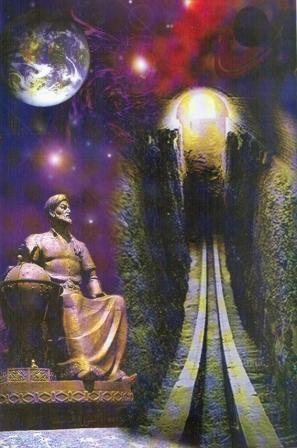 Among the historical monuments of Samarkand, the special place occupied by the remains of the observatory, built by Ulugbek on the Kuhak hill near Samarkand in 1424-1428 years.
Among the historical monuments of Samarkand, the special place occupied by the remains of the observatory, built by Ulugbek on the Kuhak hill near Samarkand in 1424-1428 years.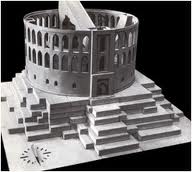 In the Ulugbek observatory, have worked such major astronomers as Kazi-zade Rumi, Giesiddin Jamshid Kashi, Ali Kushchi. The observatory was equipped with the best and most sophisticated tools at the time. At present, expressed a very plausible assumption that the main instrument through the observatory determined the basic constants of astronomy: the inclination of the ecliptic, equinoctial points, the duration of the star, and other quantities derived from observations of the Sun, planets and moon. The sheer size of the sextant, a successful design and mastery of Samarkand astronomers have provided high-precision observations.
In the Ulugbek observatory, have worked such major astronomers as Kazi-zade Rumi, Giesiddin Jamshid Kashi, Ali Kushchi. The observatory was equipped with the best and most sophisticated tools at the time. At present, expressed a very plausible assumption that the main instrument through the observatory determined the basic constants of astronomy: the inclination of the ecliptic, equinoctial points, the duration of the star, and other quantities derived from observations of the Sun, planets and moon. The sheer size of the sextant, a successful design and mastery of Samarkand astronomers have provided high-precision observations.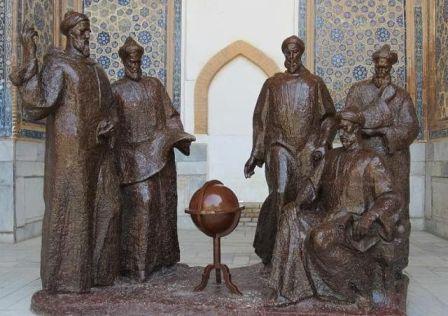 Some astronomical values were determined by Ulugbek with remarkable accuracy. In the matter of determining the ecliptic inclination Ulugbek was at the forefront of world science. By Ulugbek the inclination of the ecliptic is 23 ° 30 '17 ", then there is an error of only 0' 32". If we take into account the means and methods of observation time of Ulugbek, given that did not yet exist telescopes, its measurement should be recognized most accurate.
Some astronomical values were determined by Ulugbek with remarkable accuracy. In the matter of determining the ecliptic inclination Ulugbek was at the forefront of world science. By Ulugbek the inclination of the ecliptic is 23 ° 30 '17 ", then there is an error of only 0' 32". If we take into account the means and methods of observation time of Ulugbek, given that did not yet exist telescopes, its measurement should be recognized most accurate.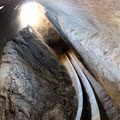 The Observatory - the construction of a special kind, and he re the main role belonged not to the architect, but to the scientist, is the location and size of the built-in building tools, that is, Ulugbek and Rumi. Their decisions were bold and original. The construction took about three years. By the fall of 1420 (other sources - to 1428 - 1429 years), the observatory building was ready. Began installation and alignment devices. At the request of Ulugbek this worked astronomer and a brilliant mathematician Giesiddin Dzhamshid Kashi.
The Observatory - the construction of a special kind, and he re the main role belonged not to the architect, but to the scientist, is the location and size of the built-in building tools, that is, Ulugbek and Rumi. Their decisions were bold and original. The construction took about three years. By the fall of 1420 (other sources - to 1428 - 1429 years), the observatory building was ready. Began installation and alignment devices. At the request of Ulugbek this worked astronomer and a brilliant mathematician Giesiddin Dzhamshid Kashi.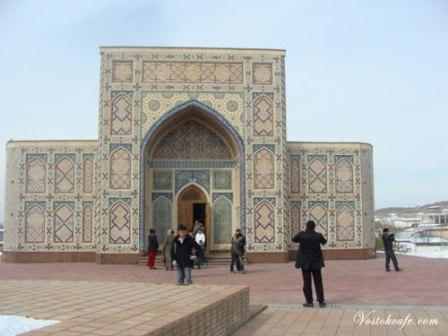 Recent studies have shown that after the death of Ulugbek Observatory has continued to work for 20 years. Only in 1469, after the assassination of ruler of Samarkand Abu Sayyid, scholars situation deteriorated so much that Ali Kushchi with the disciples had to leave the observatory and moved to Herat, where the first minister of state was an outstanding East poet of and statesman Alisher Navoi, who provided patronage and support, including materially, scientists, thinkers, artists, musicians and poets. Soon Samarqand astronomer was invited to Istanbul. There, he completed and published the works of the observatory. Thus, the Observatory ceased operations, was killed Ulugbek, but Ali Kushchi had saved star table and told the world about his teacher. Ulugbek went to live in his writings and his fame grew.
Recent studies have shown that after the death of Ulugbek Observatory has continued to work for 20 years. Only in 1469, after the assassination of ruler of Samarkand Abu Sayyid, scholars situation deteriorated so much that Ali Kushchi with the disciples had to leave the observatory and moved to Herat, where the first minister of state was an outstanding East poet of and statesman Alisher Navoi, who provided patronage and support, including materially, scientists, thinkers, artists, musicians and poets. Soon Samarqand astronomer was invited to Istanbul. There, he completed and published the works of the observatory. Thus, the Observatory ceased operations, was killed Ulugbek, but Ali Kushchi had saved star table and told the world about his teacher. Ulugbek went to live in his writings and his fame grew.














